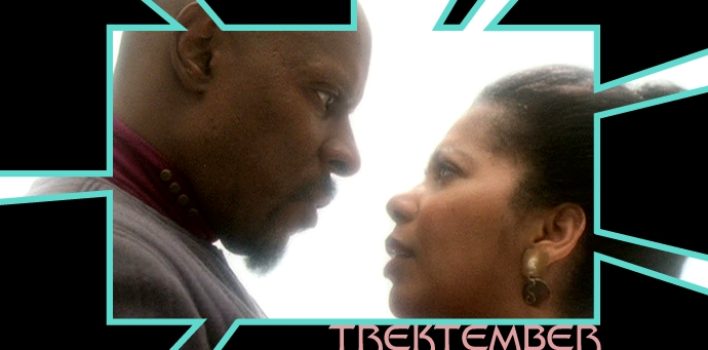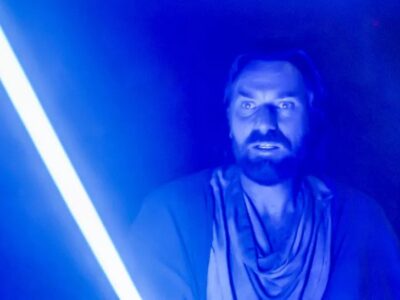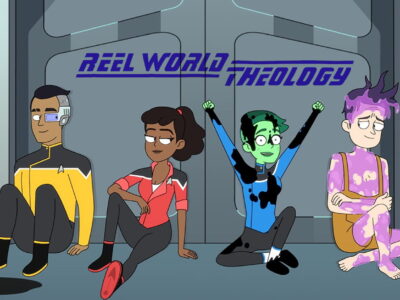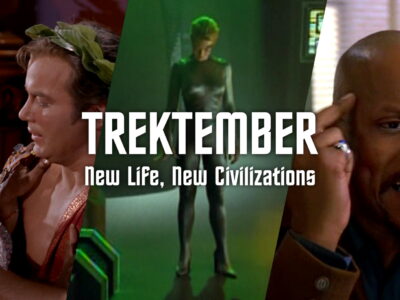Trektember: What You Leave Behind
In my post about this episode on my own blog, I talked about how frustrated, even angry I was about the way Deep Space Nine ended when I first saw it. But I also alluded to something beautiful in it as well. Well, here it is, folks. Quite unintentionally, I found another Christ figure in Star Trek. (You can find information on the first Christ figure of Star Trek here and, much more extensively, in my book, The Gospel According to Star Trek: The Original Crew.)
I’ll admit it was somewhat annoying to find this because it would have been so much easier to just hate the end of DS9. Instead, I’m stuck with the cognitive dissonance of, on a very human level, hating that all those great family relationships, romances and friendships are broken up in the series finale and especially that Ben’s new baby needs a Daddy, while still finding a beautiful image of Jesus in the narrative. In fact, it is my very sorrow at Ben Sisko’s departure that makes this image so strong.
So, how does Ben Sisko qualify as a Christ figure? First, let’s look at something he shares with Spock, our other Star Trek Christ figure: a dual nature. We discover that Ben’s mother is not the woman who raised him. Instead, his real mother was a woman who has been taken over by one of the Prophets, the gods of Bajor.
So, he is of mixed human and superhuman (or human and divine) lineage. He’s part Prophet. This of course reflects (in a limited way) Jesus’ dual nature as human and Divine. Like Jesus, he struggles with his divine calling and his human desires, ultimately choosing to surrender to the will of the Prophets the way Jesus chose to surrender to God, his Father.
The gender roles are reversed in Sisko’s parentage, as he has a human father and (for the sake of this metaphor) a divine mother. So it is his mother’s will to which he submits, but the surrender occurs nonetheless. Indeed, as the series progresses, the Prophets begin to appear to Benjamin only as Sarah, his real mother.
Like Jesus, Sisko has not only human and divine parentage, but an earthly human who raised him alongside his human parent. Ben has a non-Prophet mother, just as Jesus had Joseph, a human father.
Sisko’s destiny is one of pain and sacrifice. He is the chosen one, the savior of Bajor and indeed the entire galaxy, as Dukat’s description of a universe set aflame clearly indicates that the Pah-wraiths do not intend to stop at destroying Bajor. In the same way, Jesus was sent as a Jewish Messiah, initially appearing to only represent salvation for the Jewish people. Instead, the salvation he brings is universal–for all people.
Indeed, the Bajoran people reflect the Jews, a deeply religious people who live under a kind of Theocracy and have been a persecuted, occupied people for many years. Here, Benjamin deviates from Jesus a bit in that he is not Bajoran by birth. But, as the Prophets note, “the Sisko is of Bajor,” indicating that, likely because he is connected to the Prophets, he is in some way Bajoran. In fact, he intends to live out his life on Bajor after the war.
In this way, the Bajorans are ultimately Sisko’s people, even if not in an ancestral sense. Nonetheless, though he is sent first to them (as Jesus said he was sent to “the lost sheep of Israel”), he was ultimately sent to save all beings in the universe. It is not insignificant that this salvation is not just of lives, of souls, but of planets and stars, just as Jesus was sent to save not just people, but the whole of Creation.
Then, just as Jesus struggled with the Sanhedrin and with Rome, Sisko struggles with the corrupt religious and political authorities on Bajor. Winn is his Caiaphas, though she is ultimately instrumental in the completion of his mission. Similarly, the real Caiaphas, Pilate and even Judas also helped Jesus complete his mission by conspiring to crucify him. Jesus’ seeming human enemies were not his true adversaries; Satan was. In the same way, Sisko’s real enemies are the Pah-wraiths.
The Pah-wraiths are consistently similar to demons and to Satan, first appearing when they “possess” Keiko. In addition to living in the fire caves and appearing as flame themselves (reflecting the fires of Hell), they are also serpentine, snake-like, recalling Lucifer as the serpent of Eden.
Ultimately, they possess Dukat, returning him from his Bajoran form to his true Cardassian nature. As Satan hides his true nature by appearing as an angel of light, so Dukat appears as a kind, harmless Bajoran whose name just happens to be Anjohl (pronounced “Ann-jul”). But, in the end, Dukat’s true nature is revealed as that of his reptilian, Cardassian self, again a snake-like image for the personification of the Devil.
In the end, like Jesus, Benjamin must sacrifice himself. But by his death, he casts the Devil (Dukat) and all his works (the Kasst Amojin) into a literal lake of fire. It is a picture both of Christ’s victory that was won on the cross and the ultimate judgment that awaits Satan.
Then, just as Jesus appeared in the upper room to his disciples (his Church, his Bride) so Benjamin appears to Kassidy (his bride) in a kind of upper room–her mind. This return of sorts does not include (as Spock’s story does) a literal bodily resurrection, but it is nonetheless a moment where the chosen one who has died to save all returns to his beloved and promises before leaving again that he will return.
When? Ben doesn’t know. It’s not linear, he tells Kassidy. It could be in a year or yesterday. In the same way, Jesus said that no one–not even he–knows the day or hour of his return, but only his Father in Heaven.
So, as Nerys and Jake look out into the sky through the window of Deep Space Nine and we pull back into the vastness of space, leaving them and their world far behind, it is as though we see them from Ben’s perspective, awaiting his return. And, seeing their eyes cast out to the stars, I can’t help but think of the words an angel once spoke to people who were looking upward for their savior: “Men of Galilee, why do you stand here looking up into the sky? This same Jesus who has been taken up from you into heaven will come back in the same way you saw him go into heaven.” (Acts 1:11, NET)
And so, the sorrow I felt at Benjamin’s departure, my ache for him to return to his friends and family, reflects our own desire in our present time for Christ’s return. We stand here, the Bride without her Beloved, longing for him to come back and claim us as his own.
This sorrow and separation is incredibly important in the finale as a thematic preamble to hope, with the series ending in a sort of eschatological melancholy, with which we find ourselves engaged in the space of the “already/not yet” state of redemption.
Remember also that Kassidy is pregnant. Benjamin will, in a sense, continue through her. In the same way, Jesus left the seed of faith in the remnant who followed him and they spawned generations who continue to look for his return. We trust with Jesus, as with Benjamin, that the Divine plan will bring restoration and wholeness to all–that even those of us who can only now long for our savior’s return will be made complete.
In that same sense of Kassidy’s pregnancy, however, the second Advent of Christ is also a continuing Advent as those who seek to follow him strive to be, as the Apostle Paul describes us, his Body. In the same way that Colonel Kira takes up Sisko’s baseball with a toss and catch echoing that of her predecessor, so we also are called to take up, continue, and even exceed the work of Jesus.
“The more things change,” Quark says in the series’ final spoken line, “the more they stay the same.” It may seem odd that DS9‘s writers chose to end the series on this oft-repeated truism, but it seems important to note that this phrase also echoes the words of the ancient liturgy, “As it was in the beginning, is now, and ever more shall be.” Perhaps the existential hope and ache of longing amidst the separation we feel from how things should be and where we belong is something akin to the formless void Genesis describes in the beginning. And perhaps the Spirit of God still hovers over the face of the deep sense we have that all is not right. But, mirroring Nog’s words from “It’s Only a Paper Moon,” it will be.







